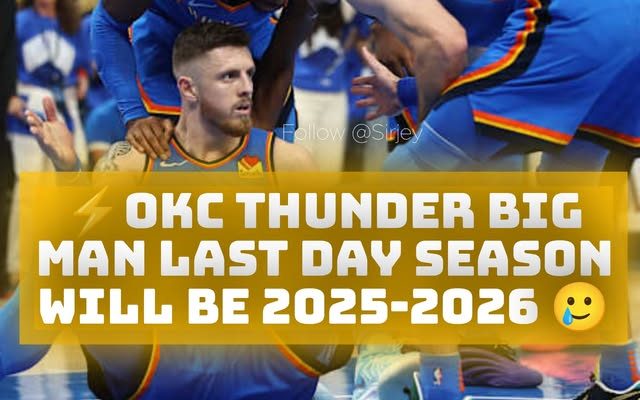When the Oklahoma City Thunder landed Isaiah Hartenstein in free agency just a year ago, the move was heralded as one of the franchise’s boldest and most ambitious acquisitions since their relocation from Seattle. At three years and \$87 million, it stood as the richest free agency contract in team history—a commitment that signaled their readiness to contend and a belief that the former New York Knicks big man would be a foundational piece in a new era of championship aspirations. Now, following a historic season in which the Thunder hoisted their first NBA title since the move to Oklahoma, Hartenstein’s presence seems to have already delivered on much of its promise. Alongside the up-and-coming Chet Holmgren, he formed a ferocious frontcourt pairing that anchored one of the league’s most suffocating defenses and most dynamic offenses. But even as confetti still lingers in the corners of Paycom Center and the trophy shines under fresh lighting, whispers surrounding Hartenstein’s long-term future with the organization have grown steadily louder—and more ominous.
Hartenstein remains under contract with two fully guaranteed seasons left on his deal, pocketing \$58.5 million over that stretch. Yet it’s the fine print in the third year—an unguaranteed club option for 2026-27 worth \$28.5 million—that looms large. On paper, it appears to be a simple structural detail. In practice, it may end up as the lever Sam Presti pulls to keep his franchise from spiraling into financial chaos under the NBA’s ever-tightening collective bargaining agreement and the looming specter of the second apron. In fact, there’s a growing belief that the franchise was never planning to see Hartenstein’s contract to completion from the start.
That belief has only been intensified by Presti’s recent financial maneuvers. Oklahoma City made headlines this offseason not only for their championship celebration but for locking up their homegrown stars—Shai Gilgeous-Alexander, Jalen Williams, and Chet Holmgren—at a combined commitment of over \$822 million. That jaw-dropping figure nearly guarantees that the Thunder will be flirting with, if not vaulting past, the league’s most punitive luxury tax thresholds. Under the new collective bargaining agreement, breaching the second apron brings a swath of punitive measures: loss of mid-level exceptions, restrictions on future trades, and limitations on adding talent via buyouts or exceptions. For a team looking to build not just a winner but a sustainable dynasty, avoiding that financial quicksand is imperative.
This context puts Hartenstein’s contract into sharp focus. In the 2026-27 season, his \$28.5 million would rank as the fourth-largest salary on the team, even before accounting for potential extensions or additions. It’s a luxury few contending teams can afford for a complementary piece, regardless of how impactful he’s been. While his defensive presence, rebounding prowess, and offensive versatility have all contributed to OKC’s success, the current cap reality is that such attributes may need to come at a lower cost—or from younger, more financially manageable players.
And it seems Presti has already begun stacking contingency plans. The Thunder’s selection of Thomas Sorber in the most recent NBA Draft raised eyebrows. A bruising and versatile big man with a refined defensive acumen and a growing offensive game, Sorber profiles as a potential long-term replacement for Hartenstein, particularly in small-ball and hybrid lineups. His rookie contract—especially if he develops quickly—offers cost control and upside in equal measure. Combine this with the re-signing of Branden Carlson on another two-way deal, and the trend becomes harder to ignore. Oklahoma City is laying the foundation for a world in which Hartenstein is no longer a part of the blueprint.
What’s remarkable, and perhaps a little tragic, is that all of this comes after one of the most successful seasons in franchise history. Hartenstein wasn’t just a contributor—he was a catalyst. His ability to share the court with Holmgren gave Mark Daigneault tremendous lineup flexibility, allowing the Thunder to toggle between rim protection, switchability, and spacing without missing a beat. Their combination proved so effective that many analysts called them the best frontcourt tandem in basketball. And it wasn’t just optics or numbers—it was impact. Hartenstein’s screening, passing from the elbows, and ability to protect the paint without fouling turned the Thunder into a matchup nightmare on both ends. His presence elevated Holmgren’s game as well, allowing the lanky sophomore to roam more freely on defense and conserve energy on offense. The synergy was textbook, the results undeniable.
Yet in professional sports, success doesn’t always secure security. In fact, success often accelerates hard decisions. With the core trio now locked in long term and the supporting cast getting increasingly expensive, Presti has been forced into forward-thinking choices. That means exploiting every cost-cutting mechanism available—trades, draft development, and yes, team options. The moment the ink dried on Hartenstein’s deal, the countdown may have begun.
It’s not that Oklahoma City doesn’t value what he brings. On the contrary, their decision to sign him in the first place reflected a deep appreciation for his intangibles, his effort, and his stylistic fit alongside a team on the rise. But NBA front offices are increasingly driven by cap dynamics, and as we’ve seen with teams like the Golden State Warriors and Boston Celtics, even the most successful rosters can be dismantled if the ledger doesn’t balance. Oklahoma City has already seen what can happen when big spending isn’t paired with strategic foresight. The inclusion of the third-year club option into Hartenstein’s deal may have been less about caution and more about inevitability.
For Hartenstein, this looming uncertainty presents a difficult emotional tightrope. On one hand, he’s heading into the 2025-26 season as a defending champion, a core part of a team poised to chase a rare repeat. On the other hand, he’s staring down what increasingly looks like a swan song. How does a player approach such a moment? If history is any guide, Hartenstein is likely to double down on the grit and consistency that earned him this deal in the first place. He’s never been one to complain or coast. His role may become more symbolic this season—part anchor, part mentor, part cautionary tale.
The Thunder, meanwhile, will continue to enjoy the fruits of their savvy offseason. Few teams are able to reload and plan for the future while still competing at the highest level, but Presti seems determined to have it all. In fact, he may already be playing the next move. If Sorber and Carlson show even a flash of readiness this season, the Thunder could test trade markets before next summer arrives, offering Hartenstein as a high-value expiring deal to a team desperate for rim protection and leadership. Such a move would not only relieve cap pressure but also help Oklahoma City recoup assets before the option year even comes into play.
In the end, this is the paradox of the NBA in the post-apron world. Contracts are less about performance and more about planning. A player can thrive on the court and still find himself on the way out. Isaiah Hartenstein’s time in Oklahoma City may indeed be nearing its end—not because he failed, but because he delivered exactly what the Thunder needed at exactly the right time. As they look toward an ambitious future with a title already in the trophy case and the financial stakes higher than ever, the writing is becoming clearer by the day. This season may be a celebration, a victory lap, and a farewell tour all wrapped into one. Hartenstein’s role might be temporary, but his impact won’t be forgotten.



